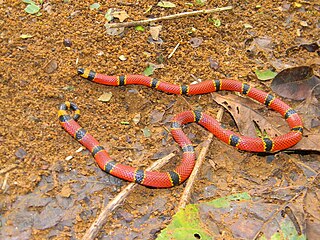
Coral snakes are a large group of elapid snakes that can be divided into two distinct groups, the Old World coral snakes and New World coral snakes. There are 27 species of Old World coral snakes, in three genera, and 83 recognized species of New World coral snakes, in two genera. Genetic studies have found that the most basal lineages have origins in Asia, suggesting that the group originated in the Old World. While new world species of both genera are venomous, their bites are seldom lethal; only two confirmed fatalities have been documented in the past 100 years from the genus Micrurus. Meanwhile, snakes of the genus Micruroides have never caused a medically significant bite.

Micrurus is a genus of venomous coral snakes of the family Elapidae.

Micrurus tener, commonly known as the Texas coral snake, is a species of venomous snake in the family Elapidae. The species is native to the southern United States and adjacent northeastern and central Mexico. Five subspecies are recognized as being valid, including the nominotypical subspecies, Micrurus tener tener, which is found in both the US and Mexico, and is also commonly known as the Texas coral snake. The species Micrurus tener was once considered to be a subspecies of the eastern coral snake.

Micrurus fulvius, commonly known as the eastern coral snake, common coral snake, American cobra, and more, is a species of highly venomous coral snake in the family Elapidae. The species is endemic to the southeastern United States. It should not be confused with the scarlet snake or scarlet kingsnake, which are harmless mimics. No subspecies are currently recognized.

Micrurus hemprichii, commonly known as Hemprich's coral snake and the worm-eating coral snake, is a species of venomous coral snake in the family Elapidae. The species is native to South America.

Micrurus nigrocinctus, commonly known as the Central American coral snake, is a species of a highly venomous snake in the family Elapidae. The species is endemic to Latin America from southern Mexico, Central America, to north Colombia. There are six recognized subspecies, including the nominate subspecies described here.
Micrurus stuarti is a species of venomous snake in the family Elapidae. The species is endemic to Guatemala. There are no recognized subspecies.

Micrurus browni, commonly known as Brown's coral snake, is a species of venomous snake in the family Elapidae. The species is native to Guatemala and southwestern Mexico. There are three recognized subspecies, including the nominate subspecies described here.

The Roatán coral snake also known as Coral de la Isle de Roatán or Coral Roatanense in Spanish is a critically endangered species of elapid snake, endemic to the island of Roatán off of the coast of Honduras. There are no recognized subspecies.

Bogert's coral snake is a species of venomous snake in the family Elapidae. The species is endemic to southern Mexico.

The elegant coral snake is a species of elapid snake, native to southern Mexico and Guatemala. There are two recognized subspecies.

Micrurus hippocrepis is a species of elapid snake, native to Guatemala and Belize. There are no recognized subspecies.

Micrurus diastema, commonly known as the variable coral snake, is a species of venomous snake in the family Elapidae. The species is endemic to southeastern Mexico and northern Central America. There are seven recognized subspecies.

Micrurus annellatus, commonly known as annellated coral snake, is a species of venomous elapid snake native to southeastern Ecuador, eastern Peru, Bolivia, and western Brazil. There are three recognized subspecies, including the nominate subspecies described here.

Micrurus corallinus is a species of highly venomous elapid snake native to South America. There are no recognized subspecies.

Micrurus latifasciatus, the long-banded coral snake or broad-ringed coral snake, is a species of elapid snake, native to southern Mexico and Guatemala. There are no recognized subspecies.

Micrurus mipartitus is a species of coral snake in the family Elapidae. It is found in South and Central America. The redtail coral snake is common in agricultural areas in Colombia. Its highly neurotoxic venom is known to cause seizures in its prey by activating nerve proteins responsible for seizures within it.

Pituophis deppei, commonly known as the Mexican bullsnake and the Mexican pine snake, is a species of nonvenomous colubrid snake endemic to Mexico. There are two recognized subspecies.

Pituophis lineaticollis, commonly known as the Middle American gopher snake or the cincuate bull snake, is a species of nonvenomous snake in the family Colubridae. The species is native to Guatemala and southeastern Mexico. There are two recognized subspecies.

Micrurus diana, also known commonly as Diana's coral snake, is a species of venomous snake in the family Elapidae. The species is native to South America.




















